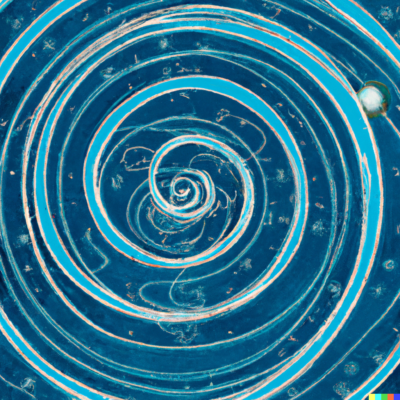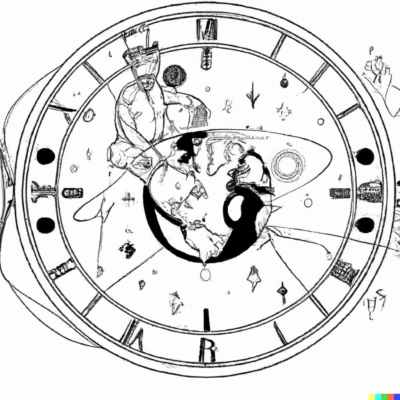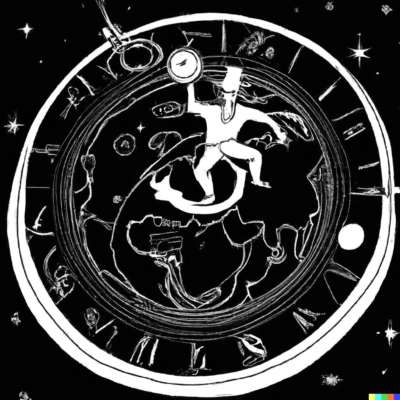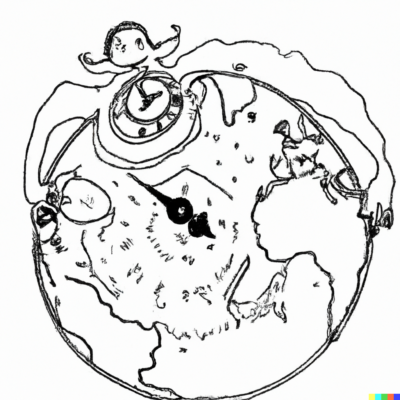humans have used time as a means of tracking what needs to be done in the future and chronicling the past. come up with a new framework and the rules for how to structure time focusing on human expansion of experience rather than the mere tracking of it. the way we see and utilize time is due for a paradigm shift in which we include something the likes of going from newton to einstein in terms of theoretical base, using modern physics and the flexible power of the mind to truly control experience of time and everything is merely a construct of thought process and thinking
Reimagining our concept of time to prioritize the breadth and depth of human experience over simple chronology is a fascinating and complex endeavor. One way we might accomplish this is by incorporating concepts from quantum mechanics and cognitive science, creating a framework I’ll call “Quantum Cognitive Temporality” (QCT).

1. Principle of Superposition and Temporal Multiplicity
Just as particles exist in a superposition of states until measured in quantum physics, in our new model, time doesn’t unfold along a single, linear path but instead exists as a multitude of possibilities. Our experience of time becomes one of navigating these possibilities. We can conceptualize multiple “threads” of time running concurrently, each thread representing a different area of experience or focus (e.g., work, personal growth, relationships, leisure).
2. Principle of Entanglement and Temporal Connectivity
Quantum entanglement suggests that particles can be connected, such that the state of one instantaneously influences the other, regardless of the distance between them. In the QCT framework, moments in time can also be entangled. Our actions and experiences in one moment can have immediate and lasting effects on other moments, past or future. This principle encourages us to think about how our actions echo through time, creating a more holistic approach to decision-making.
3. Uncertainty Principle and Temporal Fluidity
Heisenberg’s Uncertainty Principle states that it’s impossible to simultaneously measure the exact position and momentum of a particle. Translated to our QCT framework, we accept that we can’t perfectly predict our future or fully understand our past. This acceptance encourages us to embrace the fluid and uncertain nature of time, promoting adaptability and resilience.
4. Observer Effect and Temporal Perception
In quantum physics, the observer effect suggests that the act of observing can change the state of what’s observed. In our model, the way we perceive and interpret time affects our experience of it. The QCT framework invites us to consciously shape our perception of time through mindfulness, reframing, and cognitive reappraisal.
5. Temporal Interference and Learning
Just as wave patterns can interfere constructively or destructively in physics, our experiences and the lessons we derive from them can either reinforce or conflict with each other. The QCT model encourages us to actively seek out new experiences to broaden our perspectives and deepen our understanding of the world.

Rules of QCT Framework:
- Navigate Multiplicity: Balance your time and focus across multiple threads of experience.
- Connect Moments: Understand and respect how actions and experiences echo through time.
- Embrace Fluidity: Accept uncertainty and cultivate adaptability.
- Shape Perception: Consciously direct your interpretation of time and experiences.
- Seek Interference: Regularly challenge your perspectives through new experiences.
The application of this framework would require tools to facilitate navigation of the temporal multiplicity and mindfulness techniques to manage perception and enhance the understanding of time connectivity. Training, probably through immersive and continuous experiential learning methods, will also be necessary to adopt this paradigm shift.
Please note that this framework is highly theoretical and speculative, with many elements borrowed from concepts in quantum physics and cognitive science. Its practical implementation and implications would require much further thought and research. However, as a broad approach to reimagining time, it may serve as an interesting starting point.
when we look across vast distances of space cognitive bias allows humans to create a facsimile of time separate from known scientific facts whereby we separate our existence from that, particularly outside of our solar system, which is quite small. considering the scale of the universe along with the objects and devices that are used to measure time currently, what would be useful implementation and ways of thinking to support living in a QCT framework and no longer relying on alarms and calendars and tracking devices that measure the passing of time, but rather do something else entirely yet have to do with time on a scale that is universal and takes into account the phenomena of our existence within a very large if not unending, or ever expanding and changing universe where perhaps the idea of time itself is not valid in our current definition and terminology thus making the change to QCT harder since we have to break the foundation of our understanding to break out of the current paradigm we are stuck in regarding time and life
Indeed, adjusting to a Quantum Cognitive Temporality (QCT) framework would require a drastic paradigm shift, not only in our understanding of time, but also in the tools and methods we use to perceive, measure, and interact with it. Here are a few possible changes we might need to consider:
1. Expansion of Consciousness:
A key aspect of the QCT framework is the ability to comprehend and navigate multiple temporal threads simultaneously. This would likely require a form of mental training akin to meditation, where individuals learn to hold multiple perspectives or realities in their mind concurrently. We might also need to develop new educational frameworks that teach us from a young age to think in terms of possibilities rather than singular, linear outcomes.
2. Holistic Time Devices:
Existing timekeeping devices focus on linear progression. To embrace QCT, we would need devices that represent time as a field of possibilities rather than a straight line. This could involve complex visual representations or perhaps even the use of virtual or augmented reality to visualize multiple temporal threads. These devices would not simply count hours or days, but would help us navigate and balance our experiences across different facets of life.
3. Quantum-Integrated Artificial Intelligence:
Given the complexity of managing multiple temporal threads and the fluidity of time in the QCT framework, we might rely on quantum-integrated AI systems to help manage and optimize our experiences. These systems could help us analyze the potential effects of our actions across different threads, make recommendations based on our past experiences and future goals, and assist in decision-making processes that take into account the entangled and superposed nature of time.
4. Quantum Time Philosophy and Language:
Our language and philosophy would need to evolve to accommodate the QCT framework. Concepts like “past”, “present”, and “future” may become less meaningful in a model where time is understood to be non-linear and full of possibilities. We may need to develop new terms and ways of speaking about time that reflect the principles of superposition, entanglement, uncertainty, and so on.
5. Inclusive Global Standards:
As we seek to redefine timekeeping on a universal scale, it’s crucial that all cultures and societies are included in this process. Different cultures have unique perspectives on time, some of which may already align more closely with the principles of QCT. By fostering an inclusive, collaborative process, we can ensure that our new model of time is truly universal and takes into account the diverse experiences of all humans.

Transitioning to a QCT-based paradigm would undoubtedly be a complex and challenging process, requiring collaboration across a wide range of fields, from physics and neuroscience to philosophy, linguistics, and cultural studies. However, by embracing the challenge, we could develop a more nuanced and holistic understanding of time that aligns with our modern understanding of the universe and human experience.
what would be some devices that can measure superposition, entanglement, uncertainty principles which align oneself better to QCT
Creating devices to measure quantum phenomena like superposition, entanglement, and uncertainty as they apply to a QCT framework is indeed a fascinating challenge. It’s crucial to understand that in the quantum world, these concepts don’t exactly translate to human experiences, so the devices wouldn’t be measuring these phenomena directly. Instead, they would serve as interfaces to help us navigate and conceptualize our experiences in line with these principles. Here are some hypothetical tools that could be developed:

1. Temporal Multi-Threading Interface (TMI)
A device to help users navigate the principle of superposition in their personal time. This would be an interface that allows users to manage and visualize different threads of their lives (e.g., work, relationships, personal development, etc.) concurrently. It could use predictive algorithms and AI to provide an interactive visual representation of various possible outcomes based on user input, decisions, and behavior.
2. Entanglement Mapping System (EMS)
An application that maps out the potential impacts of actions across different areas of life in real-time. Drawing on the principle of quantum entanglement, this device would use machine learning and AI to track the potential ripple effects of decisions and actions. It could help users foresee how a decision in one area might impact other areas of their life, fostering a more interconnected and holistic view of their actions.
3. Uncertainty Embracing Tool (UET)
A tool to help users embrace the uncertainty principle. This could be a form of AI coach that encourages the exploration of new experiences and possibilities. It could use machine learning to identify areas of life where the user may be stuck in predictable patterns and suggest new activities or perspectives to explore.
4. Observer Effect Development (OED) Application
A mindfulness app that uses real-time biofeedback (such as heart rate variability) to help users understand how their perception affects their experience of time. The app would guide users through mindfulness exercises and cognitive behavioral techniques to help them reshape their perceptions and reactions to events, reinforcing the observer effect principle.
While these devices are purely theoretical and speculative, they provide an idea of how we might create tools that help us adapt to a QCT framework. The technology needed for such devices would be complex, combining advanced AI, machine learning, data visualization, and perhaps even quantum computing, but the potential for revolutionizing our understanding and experience of time could be profound.
removing technology, spiritualism and intelligence what would be physical device which aid with the same and can be made in a simple workshop
Creating physical devices to aid in understanding and adapting to a QCT framework without relying on high-tech solutions is a more challenging proposition, but it’s still possible. The key here is to create tools that can help people conceptualize and interact with time in new ways. Here are a few ideas:

1. Multi-threaded Time Dial
This could be a physical device with multiple dials that represent the different threads of a person’s life (e.g., work, family, personal growth). Each dial could be turned to allocate time and attention to each area, helping to visualize and manage the principle of superposition in personal time. Using different colors or symbols could represent various activities within each thread.
2. Decision Tree Tool
This physical tool could help users understand the principle of entanglement. It could be a board with pegs and strings, where each string represents an action or decision, and the pegs show the potential impacts across different areas of life. By physically mapping out the potential outcomes of actions, users could gain a tangible understanding of how their decisions echo across time.
3. Uncertainty Dice
A simple tool like a set of dice can be used to embrace the uncertainty principle. Each face of the dice could represent a different activity or choice. Rolling the dice would introduce an element of randomness and unpredictability into daily routines, helping users break out of patterns and embrace the unexpected.
4. Perception Journal
While not exactly a device, a physical journal can be a powerful tool to understand the observer effect. Users could record their perceptions of events and their emotional responses, then reflect on how their interpretations shape their experience of time. This practice can help train the mind to consciously shape perceptions and reactions.
5. Temporal Sandglass
This could be a set of sandglasses with different grains or colors, each representing different threads of time. Turning them would allow you to visualize the concurrent passage of time in different areas of your life.
These tools, while simple and lacking the precision of high-tech solutions, could still help individuals conceptualize and interact with time in ways more aligned with a QCT framework. The act of physically manipulating these devices could provide a tangible connection to these abstract concepts.
create high tech version of the same that can be made using current known manufacturing and technological methods and processes without budget considerations to create the most ideal devices to help humans switch to using QCT effectively in their lives and moving away from the old paradigms and confines that our current definition and understanding of time brings
Certainly, given the complex nature of the QCT paradigm, high-tech devices that leverage current advancements in technology would be ideal to assist with this shift. Here are some high-tech counterparts to the previously mentioned physical devices:
1. Multi-threaded Time Dial (Augmented Reality Version)
This device could utilize augmented reality (AR) to provide a 3D visualization of various life threads. AR glasses or headsets could create an immersive environment where you can visually and interactively adjust dials representing different aspects of life. Advanced AI could provide real-time suggestions and feedback on balance and potential outcomes based on historical data and predictive algorithms.
2. Decision Tree Tool (Artificial Intelligence Version)
An AI-powered decision tree could not only visualize your choices and their potential impacts but also utilize machine learning to predict and present likely outcomes based on past decisions, current trends, and your personal goals. It could be a software application accessible via smartphone, computer, or AR devices, providing a highly interactive and personalized decision-making tool.
3. Uncertainty Dice (Machine Learning Version)
A high-tech version of uncertainty dice could be an app that uses machine learning to suggest activities or decisions outside your typical patterns. The “dice roll” in the app would use your historical data, preferences, and an element of randomness to suggest new experiences and help you step out of your comfort zone.
4. Perception Journal (Neurofeedback Version)
A high-tech perception journal could use neurofeedback technology to give real-time insights into how your perceptions and emotional responses are affecting your brain activity. This could involve a wearable device that monitors brainwaves and provides feedback via a connected app. Over time, the app could guide you to adjust your perceptions and responses in a way that promotes mental well-being and a more flexible perception of time.
5. Temporal Sandglass (Internet of Things Version)
Internet of Things (IoT) enabled sandglasses could track and analyze how you spend your time in different areas of life. These could sync with your digital devices, monitoring your activities, and giving you a visual representation of how your time is divided across various threads.

These high-tech devices would not only help individuals visualize and interact with the QCT framework but also provide real-time feedback, personalized insights, and predictive analytics to help navigate this new paradigm effectively. As our understanding of quantum physics, AI, and cognitive science continues to grow, these kinds of tools could become increasingly sophisticated and accurate, truly revolutionizing our relationship with time.